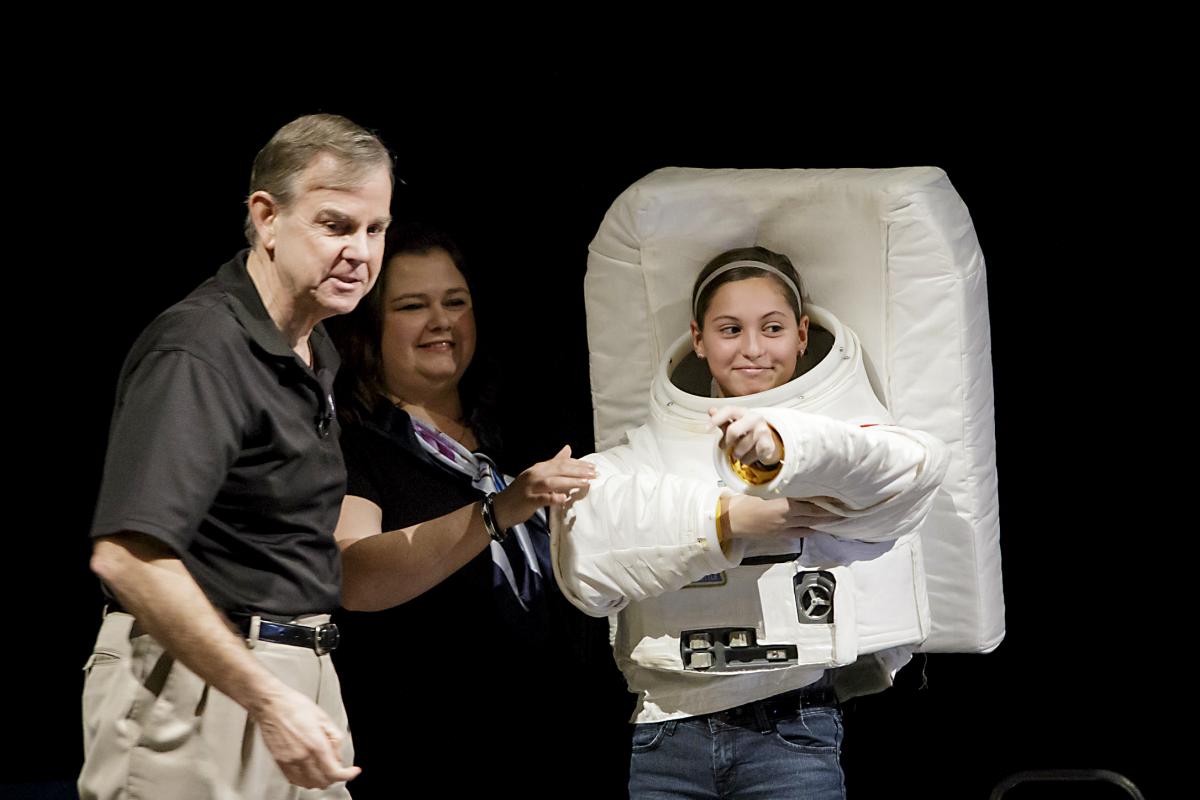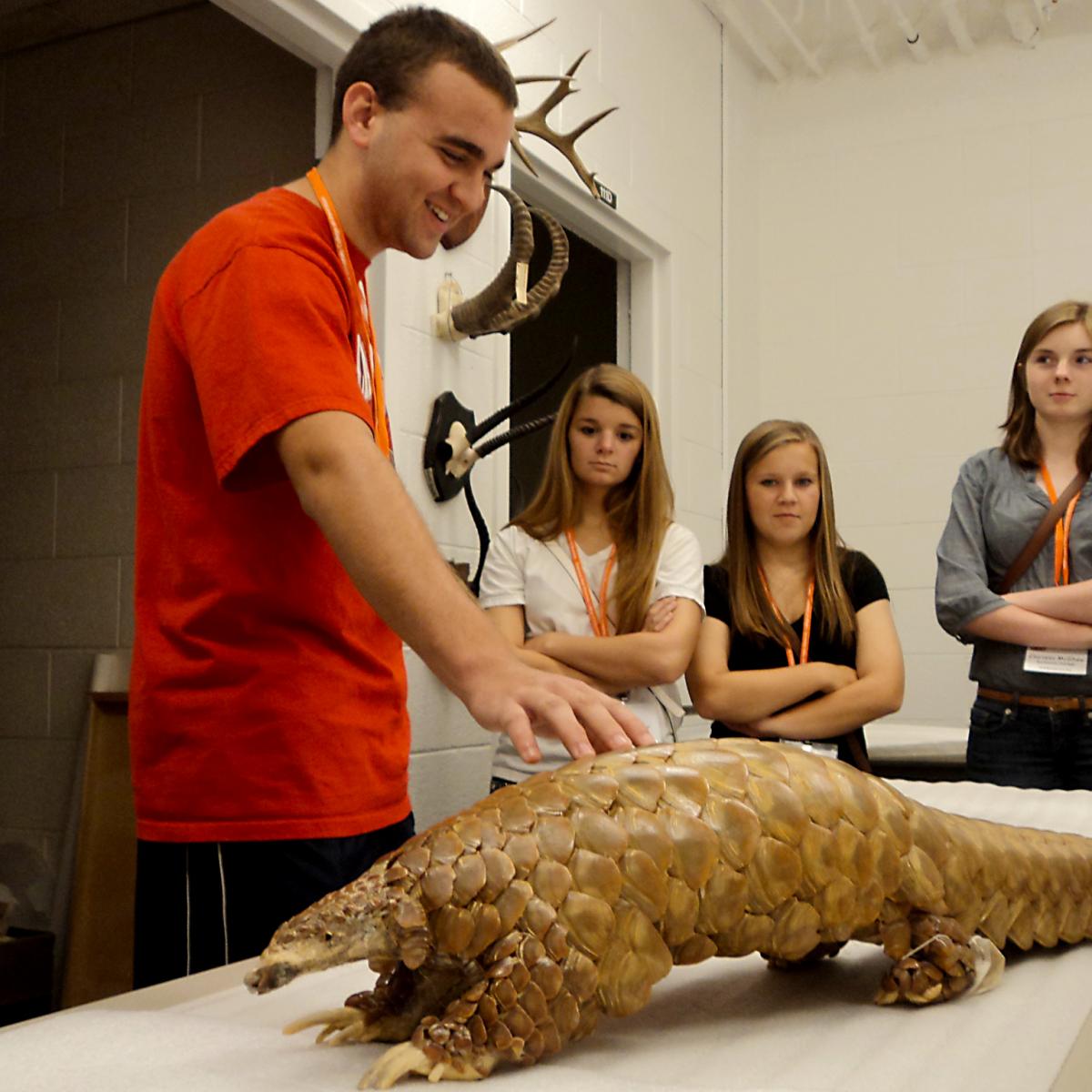STEM for the Future
Friday, February 28, 2014
This article appears in the 2014 issue of Vanguard, Oklahoma State University’s Research
magazine.
Science, technology, engineering and mathematics represent key areas in education
and employment now and for the future. The Oklahoma State University College of Education’s
efforts to prepare future teachers and professionals for STEM areas are broad and
growing, reflecting a collaborative and vibrant culture where STEM subjects are a
priority.
Broader Definition
While the College of Education’s working definition of STEM starts with science,
technology, engineering and mathematics education, it doesn’t end there.
“We prepare teachers of math and science, and elementary and special education teachers
who have emphases in these areas,” College of Education Dean Pamela “Sissi” Carroll says. “Beyond the usual definitions, though, our working definition includes our
STEM-active aviation and aerospace education programs, and our health and human performance
programs, including health promotion, exercise science, therapeutic recreation, recreation
management, physical education, and athletic training, each of which requires a science-strong
foundation.”
With so many science-heavy programs, opportunities for collaboration across programs
are numerous.
The college also serves as the home of NASA Education Projects at OSU. The university
has a lengthy and rich history with NASA Education, dating back more than 40 years.
Today, more than $40 million in contracts reside at Oklahoma State and reach thousands
of K-12 teachers and students across the country.
CRSTL
The Center for Research on STEM Teaching and Learning (CRSTL) has continued to grow
and expand. The center engages in a range of collaborative research and outreach projects
that aim to improve STEM teaching and learning. CRSTL matches the needs of Oklahoma
classrooms with the innovation of OSU’s premier scientists and engineers. (For more
information on CRSTL, visit http://crstl.okstate.edu)
Juliana Utley, mathematics education associate professor and Alice Phillips Professor in Elementary
Education, and Toni Ivey, assistant professor in science education, co-direct CRSTL. Faculty members from
the colleges of Education, Arts and Sciences, and Engineering, Architecture and Technology
are part of projects filtering through CRSTL, which is building a larger STEM pipeline
through its efforts.
“By fifth grade, we are already losing students from STEM fields and by eighth grade,
students have decided whether a STEM career is an option for them. Targeting early
grades is very important,” Ivey notes.
Faculty members partner with public school teachers on an array of grant-funded research
and outreach projects. In 2012, CRSTL and NASA Education Projects partnered with Stillwater
Public Schools to host one of a handful of Downlinks with the International Space
Station. More than 400 sixth-graders came to the OSU campus to communicate in real
time with NASA astronaut Kevin Ford, who was aboard the International Space Station.
Another example of a joint project is a state grant called C-3 — College, Career,
Citizen — where faculty members work with a co-op that serves many rural school districts
to implement Engineering is Elementary, a well-established curriculum from the Boston
Museum of Science.
Engineering, aerospace and energy are prominent STEM job fields in Oklahoma. There
is also a documented shortage of doctors in the state. STEM education is vital to
all of these fields, and increasing awareness of the importance of math and science
for K-12 students is an integral step.
“We are really trying to help build interest in the areas that industry is reporting
a need,” Utley says. “I think we are seeing a lot of success and an uptick in the
number of K-12 teachers’ schools desiring to work with the university.”
CRSTL participated in the Governor’s STEM Summit and an Aerospace Education Industry
Partnership Meeting in 2013. The center also has hosted a STEM Teacher Institute each
of the last two summers with plans for a third in 2014. A Broader Impacts workshop
brought together faculty members and community entities, such as the Oklahoma City
Zoo and the Oklahoma WONDERtorium, providing a place to network and make research
connections.
In the fall of 2013, Robert Raab joined the college as its first coordinator of faculty and student research initiatives,
a role that serves to connect with external funding agencies and community partners
and support faculty in research and outreach efforts.
Oklahoma STEMx Learning Network
In 2012, Oklahoma State University joined STEMx, a multistate network developed
by states, for states. A self-described grassroots movement, STEMx provides “an accessible
platform for states to share, analyze and disseminate quality STEM education tools
to transform education.” STEMx efforts aim to expand the number of STEM teachers,
increase student achievement and grow tomorrow’s innovators.
Oklahoma is one of 19 states in this collaborative effort, which is sponsored by
Battelle Inc. CRSTL serves as the official hub for the state in STEMx. Education faculty
members are working to get teachers to share knowledge with other teachers.
“There are many silos of excellence in our state,” Utley says. “The impetus behind
STEMx is to create one
hub in the state that can pull in those silos and share them with others.”
OSUTeach
The College of Education has teamed with the College of Arts and Sciences to secure
a grant that will help support a new and effective approach to recruiting and preparing
secondary science and mathematics teachers.
OSU received a $1.45 million grant from the Howard Hughes Medical Institute to implement
OSUTeach. The program is modeled after the highly successful and innovative UTeach
at the University of Texas-Austin. Launched at UT-Austin in 1997, the program has
since been implemented at 34 other universities around the country with fantastic
results. Research shows that a high percentage of program graduates enter the teaching
profession, and five years later, most of them are still teaching in schools.
“One of the greatest potential benefits of the UTeach program is the number of graduates
prepared to teach math and science for our state,” Carroll says.
UTeach was created to attract a wide range of bright science and mathematics majors
into secondary teaching careers, to prepare them through an advanced field-intensive
curriculum, and to promote professional retention through induction support and ongoing
professional development.
(For more information on OSUTeach, visit: http://osu.teach.okstate.edu)
UTeach students begin by taking two recruitment courses (the courses are one credit
hour and tuition costs are reimbursed, allowing students to try out teaching math
or science without the financial commitment). Preparation to teach includes working
in elementary, middle and high school classrooms with master teachers as they develop
inquiry-based lessons using research-based curricula and materials.
Students receive a degree in their STEM major and full teaching certification without
added time or cost. The university will raise additional funds for OSUTeach while
working toward implementation in 2014-15. Support has been provided by the Schusterman
Family Foundation and others.


